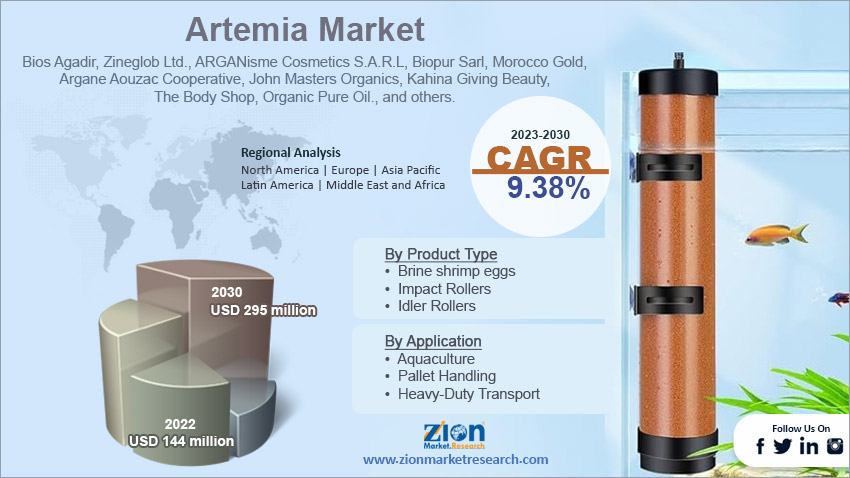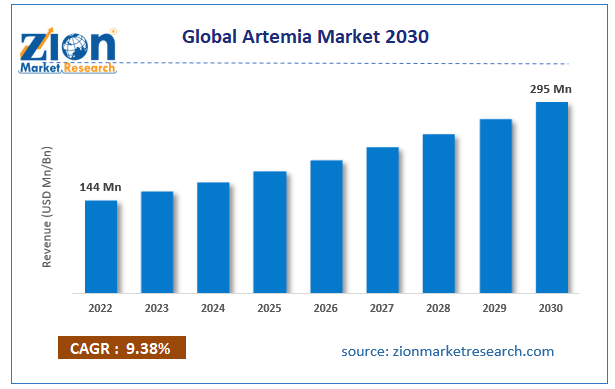Artemia Market Trend, Share, Growth, Size, Analysis and Forecast 2030

Artemia Market By Product Type (Brine Shrimp Eggs and Artemia Nauplii), By Application (Aquaculture, Pet Food, and Pharmaceuticals), and By Region - Global and Regional Industry Overview, Market Intelligence, Comprehensive Analysis, Historical Data, And Forecasts 2023 - 2030
| Market Size in 2022 | Market Forecast in 2030 | CAGR (in %) | Base Year |
|---|---|---|---|
| USD 144 million | USD 295 million | 9.38% | 2022 |
Artemia Industry Prospective:
The global artemia market size was worth around USD 144 million in 2022 and is predicted to grow to around USD 295 million by 2030 with a compound annual growth rate (CAGR) of roughly 9.38% between 2023 and 2030.
Artemia Market: Overview
Artemia is a genus of small, aquatic crustaceans that live in saltwater habitats, particularly salt pans and inland saltwater lakes. These hardy creatures have adapted to harsh conditions such as high salt levels and high temperatures. The most famous species, artemia salina, has an international distribution and is often used in aquaculture and medical studies. Because of its nutritional value and compact size, Artemia plays an important role in the aquaculture sector as a favored stay food source for fish larvae and shrimp post-larvae. Its ability to undergo cryptobiosis, a state of suspended animation, allows it to survive extreme environmental circumstances by encysting and hatching until conditions improve.
Artemia has ecological relevance beyond aquaculture, contributing to the food web in hypersaline settings. Furthermore, its adaptability and tenacity make it a valuable model organism for studying stress tolerance and developmental biology. Artemia is important in domains like as ecotoxicology and environmental tracking, where its sensitivity to contaminants makes it a standout species. Overall, artemia's unique characteristics make it a versatile and commercially significant organism with applications ranging from aquaculture to medical research.
Key Insights
- As per the analysis shared by our research analyst, the global artemia industry is estimated to grow annually at a CAGR of around 9.38% over the forecast period (2023-2030).
- In terms of revenue, the global artemia market size was valued at around USD 144 million in 2022 and is projected to reach USD 295 million, by 2030.
- The global artemia industry is projected to grow at a significant rate due to rising demand in the aquaculture industry for sustainable and nutritious live feed in fish and shrimp hatcheries.
- Based on product type segmentation, brine shrimp eggs were predicted to hold maximum market share in the year 2022.
- Based on application segmentation, aquaculture was the leading revenue generator in 2022.
- On the basis of region, Asia Pacific was the leading revenue generator in 2022.
 Request Free Sample
Request Free Sample
Artemia Market: Growth Drivers
Booming worldwide aquaculture enterprise is propelling the market growth
The thriving global aquaculture industry is the key engine driving the artemia market. As the demand for seafood continues to rise, aquaculture has emerged as a critical source for meeting this need in a sustainable manner. Artemia is an important component in aquaculture operations, particularly in the early stages of fish and shrimp larval development. Its nutrient-rich content, short length, and adaptability make it an excellent stay meal for these aquatic species, assuring their healthy growth and survival.
Furthermore, Artemia's ability to withstand a wide range of climatic conditions, along with its low cost, makes it a popular choice among aquaculture practitioners worldwide. As the aquaculture sector develops to satisfy the rising demand for high-quality seafood, the Artemia market is expected to increase steadily, owing to its critical role in helping the successful production of various fish and shrimp species. Population growth and rising disposable income are anticipated to push global fish consumption to 21.5 kg per capita by 2030. Aquaculture now accounts for more than half of all seafood consumed globally, and its importance is anticipated to grow further due to worries about the sustainability of wild-caught fish.
Artemia Market: Restraints
Vulnerability of natural artemia populations may restrain market expansion.
The susceptibility of wild artemia populations to environmental changes and habitat degradation is an exquisite constraint coursing through the artemia market. These crustaceans are typically found in hypersaline habitats, and any changes to these ecosystems, such as pollution or habitat destruction, can have a severe impact on their numbers. As a result, changes in artemia supply may also offer issues to the aquaculture industry, necessitating the development of sustainable and regulated growing methods.
Furthermore, the artemia market's reliance on saltwater settings raises worries about overexploitation and depletion of these resources. Harvesting artemia from herbal salt pans and lakes may also create ecological sustainability concerns, making it critical for the firm to investigate and implement innovative, green manufacturing practices to assure the long-term survival of the artemia market. Over half of the known artemia cyst-producing salt lakes on the planet are vulnerable or on the verge of extinction. Natural artemia populations face serious risks from habitat loss, pollution, and climate change.
Artemia Market: Opportunities
Growing trend of incorporating aquaculture practices into sustainable and circular economy models to provide growth opportunities
The expanding trend of merging aquaculture methods into sustainable and circular financial system styles represents an interesting prospect for the artemia industry. Artemia's importance in aquaculture feeds places it strategically within this paradigm shift toward ecologically acceptable techniques. As the aquaculture business embraces more sustainable approaches, there is a growing demand for green alternatives, offering an opportunity for artemia producers to improve and market sustainable production methods, reducing the industry's ecological imprint. Furthermore, the rising market for high-priced aquaculture species, such as ornamental fish and specialty shrimp varieties, provides another avenue for development.
With its nutritional profile and versatility, artemia can cater to the specific needs of those top-tier species. By focusing on niche markets and cooperating with stakeholders to develop customized artemia-based items, the sector has the ability to tap into higher-price segments, adding to the overall diversification and financial expansion of the artemia market. The Blue Growth Strategy and Common Fisheries Policy of the European Union place a premium on the development of circular and sustainable aquaculture systems. The United Nations Food and Agriculture Organization (FAO) promotes the Circular Economy Platform for Food and Agriculture (CEPF) efforts to encourage circular practices in aquaculture price chains.
Artemia Market: Challenges
Potential impact of climate change on the hypersaline environment to challenge market growth
The potential influence of weather trade in the hypersaline regions where such crustaceans live is a significant concern for the artemia marketplace. Rising temperatures, changes in precipitation patterns, and changes in saltwater environments can all affect Artemia's herbal habitats, causing oscillations in population size and availability. This climate-induced fluctuation jeopardizes the dependability of artemia as a staple feed in aquaculture, demanding adaptive strategies and enhanced resilience in the face of changing climatic circumstances.
Furthermore, the competitive landscape and market dynamics pose difficulties for artemia makers. With a growing need for sustainable and alternative protein assets in aquaculture, the industry is seeing the rise of new alternatives and enhancements. Artemia manufacturers must remain competitive by using environmentally friendly cultivating practices, increasing manufacturing performance, and innovating to meet the changing demands of the aquaculture business. Adapting to these market changes necessitates strategic planning as well as continuous efforts to improve the sustainability and value-effectiveness of artemia production.
Artemia Market: Segmentation
The global artemia market is segmented based on product type, application, and region.
Based on product type, the global market segments are brine shrimp eggs and artemia nauplii. At present, the global market is dominated by the brine shrimp eggs segment. Brine shrimp eggs are the latent and durable cyst stage of Artemia, known for their ability to withstand adverse environmental conditions and ease green storage and transportation. These eggs are a significant component of the aquaculture industry, acting as the primary source of live nutrition for fish and shrimp larvae. The brine shrimp eggs phase's dominance can be due to its adaptability, simplicity of management, and appropriateness for large-scale aquaculture operations. As the aquaculture sector expands internationally, the need for brine shrimp eggs as a reliable and nutritionally rich feed source is expected to drive this segment's continued dominance in the artemia market.
Based on application the global artemia market is categorized as aquaculture, pet food and pharmaceuticals. Out of these, aquaculture was the largest shareholding segment in the global market. The robust growth of aquaculture operations worldwide, fueled by the rising demand for seafood, has fueled the widespread use of artemia as an important component in fish and shrimp hatcheries. Artemia's nutrient-rich composition and short length make it a perfect live feed at some point during the critical larval development period, ensuring the health and strength of aquatic animals. As the aquaculture industry expands to fulfill the expanding global demand for high-quality seafood, the aquaculture segment's importance is predicted to grow, contributing significantly to artemia's overall market domination.
Artemia Market: Report Scope
| Report Attributes | Report Details |
|---|---|
| Report Name | Artemia Market |
| Market Size in 2022 | USD 144 Million |
| Market Forecast in 2030 | USD 295 Million |
| Growth Rate | CAGR of 9.38% |
| Number of Pages | 215 |
| Key Companies Covered | Bios Agadir, Zineglob Ltd., ARGANisme Cosmetics S.A.R.L, Biopur Sarl, Morocco Gold, Argane Aouzac Cooperative, John Masters Organics, Kahina Giving Beauty, The Body Shop, Organic Pure Oil., and others. |
| Segments Covered | By Product Type, By Application, and By Region |
| Regions Covered | North America, Europe, Asia Pacific (APAC), Latin America, Middle East, and Africa (MEA) |
| Base Year | 2022 |
| Historical Year | 2017 to 2021 |
| Forecast Year | 2023 - 2030 |
| Customization Scope | Avail customized purchase options to meet your exact research needs. Request For Customization |
Artemia Market: Regional Analysis
Asia Pacific to lead the market during the forecast period
During the projected period, the Asia Pacific region is likely to take the lead in the artemia market. This domination may be linked to the rapid rise of the aquaculture sector in countries throughout Asia, where there is a significant increase in the production of fish and shrimp. Aquaculture is a major driver of the artemia business, and Asia Pacific, with its large and increasing aquaculture zone, is a major customer and maker of artemia-based items. Countries such as China, India, Vietnam, and Indonesia are making significant investments in aquaculture infrastructure and production, which is fueling demand for artemia as a critical problem in aquafeed. The region's ideal climatic conditions for artemia cultivation, together with a growing awareness of the need for high-quality stay feed for aquaculture, contribute to Asia Pacific's anticipated leadership in the artemia market. The position's dominance is expected to continue as aquaculture sports expand, spurred by rising fish consumption and the demand for sustainable aquaculture methods.
Governments in various Asian nations are implementing norms and tasks to regulate the business, recognizing the importance of aquaculture for food security and economic growth. This involves encouraging artemia production and ensuring a steady supply. The Asia Pacific region now accounts for the majority of the global artemia market, accounting for more than 65%. China is the world's single largest purchaser of artemia, followed by way of Vietnam and Thailand.
Key Developments
2023: INVE Aquaculture, a pioneer in Artemia cyst technology, and San Diego Biotech, a leader in aquaculture vitamins, joined forces to develop and scale up the production of magnificent artemia cysts. The cooperation aims to create Artemia cysts with improved nutritional profiles, including unique fatty acids and nutrients, which will undoubtedly improve larval fish survival and aquaculture growth.
2023: X2 Biosystems, a biotechnology firm, announced the development of genetically engineered artemia traces capable of effectively bioremediation contaminated water. These artemia strains are designed to target specific contaminants such as micro plastics or heavy metals, accumulating them in their bodies and enabling their removal from the water.
2023: The University of Tokyo and the Japan Aerospace Exploration Agency (JAXA) are collaborating on research that will use Artemia in spaceflight experiments to study the effects of radiation and microgravity on live beings. These studies aim to gain insights into cellular adaptability and resilience in extreme settings, potentially benefiting both space travel and the development of radiation-resistant flora on Earth.
Artemia Market: Competitive Analysis
The global artemia market is dominated by players like:
- Bios Agadir
- Zineglob Ltd.
- ARGANisme Cosmetics S.A.R.L
- Biopur Sarl
- Morocco Gold
- Argane Aouzac Cooperative
- John Masters Organics
- Kahina Giving Beauty
- The Body Shop
- Organic Pure Oil
The global artemia market is segmented as follows:
By Product Type
- Brine shrimp eggs
- Impact Rollers
- Idler Rollers
By Application
- Aquaculture
- Pallet Handling
- Heavy-Duty Transport
By Region
- North America
- The U.S.
- Canada
- Europe
- France
- The UK
- Spain
- Germany
- Italy
- Rest of Europe
- Asia Pacific
- China
- Japan
- India
- South Korea
- Southeast Asia
- Rest of Asia Pacific
- Latin America
- Brazil
- Mexico
- Rest of Latin America
- Middle East & Africa
- GCC
- South Africa
- Rest of Middle East & Africa
Table Of Content
Methodology
FrequentlyAsked Questions
Artemia is a genus of small, aquatic crustaceans that live in saltwater habitats, particularly salt pans and inland saltwater lakes. These hardy creatures have adapted to harsh conditions such as high salt levels and high temperatures.
The global artemia market cap may grow owing to the due to the due to rising demand in the aquaculture industry for sustainable and nutritious live feed in fish and shrimp hatcheries
According to study, the global artemia market size was worth around USD 144 million in 2022 and is predicted to grow to around USD 295 million by 2030.
The CAGR value of the artemia market is expected to be around 9.38% during 2023-2030.
The global artemia market growth is expected to be driven by Asia Pacific. It is currently the world’s highest revenue-generating market owing to booming aquaculture industry in nations and robust economic growth witnessed in countries such as China and India.
The global artemia market is led by players like Bios Agadir, Zineglob Ltd., ARGANisme Cosmetics S.A.R.L, Biopur Sarl, Morocco Gold, Argane Aouzac Cooperative, John Masters Organics, Kahina Giving Beauty, The Body Shop, and Organic Pure Oil.
The report analyzes the global artemia market’s drivers, restraints/challenges, and the effect they have on the demands during the projection period. In addition, the report explores emerging opportunities in the artemia industry.
HappyClients
Zion Market Research
Tel: +1 (302) 444-0166
USA/Canada Toll Free No.+1 (855) 465-4651
3rd Floor,
Mrunal Paradise, Opp Maharaja Hotel,
Pimple Gurav, Pune 411061,
Maharashtra, India
Phone No +91 7768 006 007, +91 7768 006 008
US OFFICE NO +1 (302) 444-0166
US/CAN TOLL FREE +1 (855) 465-4651
Email: sales@zionmarketresearch.com
We have secured system to process your transaction.
Our support available to help you 24 hours a day, five days a week.
Monday - Friday: 9AM - 6PM
Saturday - Sunday: Closed






